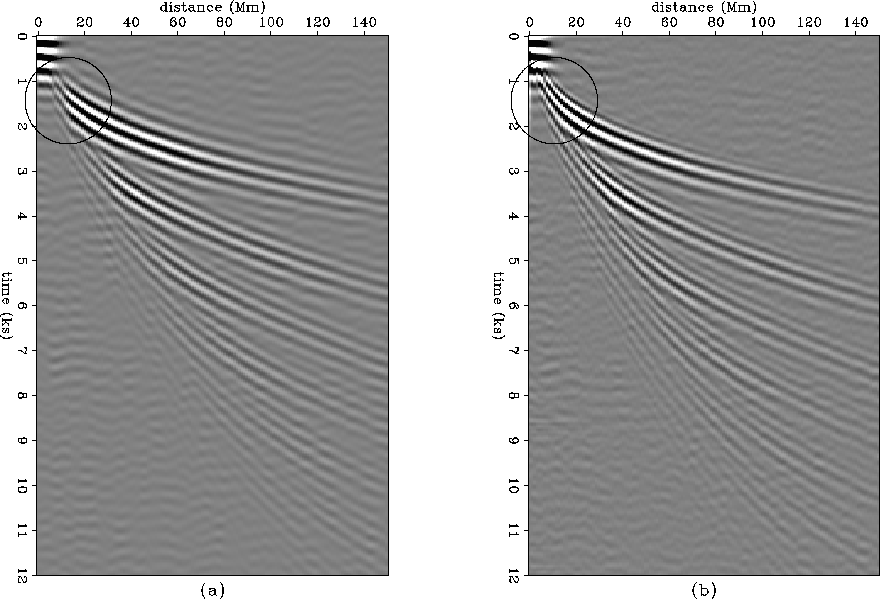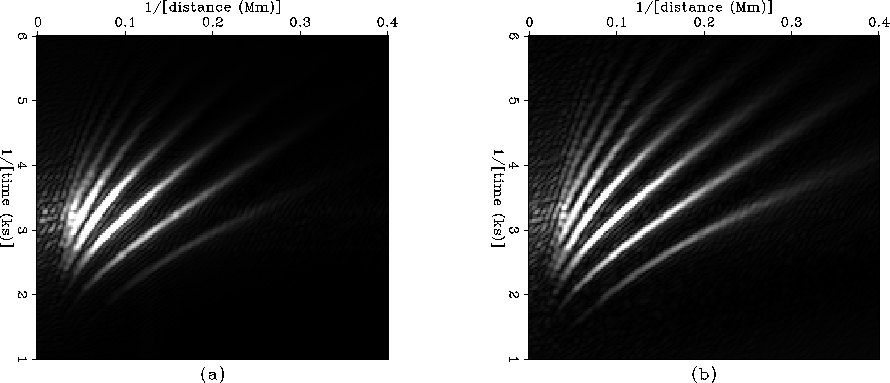




Next: Application to a terrestrial
Up: Application to SOHO/MDI dataset
Previous: Application to SOHO/MDI dataset
Figure ![[*]](http://sepwww.stanford.edu/latex2html/cross_ref_motif.gif) shows a comparison between the impulse
response derived from Kolmogorov spectral factorization, and the
impulse response derived by crosscorrelation.
shows a comparison between the impulse
response derived from Kolmogorov spectral factorization, and the
impulse response derived by crosscorrelation.
The raw MDI data has a narrow temporal bandwidth with
most of its energy having a period of about five minutes: squaring the
amplitude spectrum reduces this bandwidth even more resulting in the
monochromatic appearance of the left panel in Figure ![[*]](http://sepwww.stanford.edu/latex2html/cross_ref_motif.gif) .
Moreover, it is not just the temporal bandwidth that is decreased by
crosscorrelating traces; but the spatial bandwidth is reduced as
well. The steep dips associated with the l- and low p-modes are
clearly visible near the origin in the right panel of
Figure
.
Moreover, it is not just the temporal bandwidth that is decreased by
crosscorrelating traces; but the spatial bandwidth is reduced as
well. The steep dips associated with the l- and low p-modes are
clearly visible near the origin in the right panel of
Figure ![[*]](http://sepwww.stanford.edu/latex2html/cross_ref_motif.gif) are very heavily attenuated in the
crosscorrelation impulse response (left panel).
are very heavily attenuated in the
crosscorrelation impulse response (left panel).
This difference in spatial bandwidth can be also be seen in the
amplitude spectra of Figure ![[*]](http://sepwww.stanford.edu/latex2html/cross_ref_motif.gif) . The amplitude of l- and
low p-modes are much lower in the autocorrelation result than in
the Kolmogorov result.
. The amplitude of l- and
low p-modes are much lower in the autocorrelation result than in
the Kolmogorov result.
Whereas, the temporal bandwidth may be broadened relatively simply by
conventional deconvolution, recovering the full spatial bandwidth that
is present in the original data would be more difficult.
stacks
Figure 5 Time-distance impulse responses
computed by (a) three-dimensional autocorrelation, and (b)
three-dimensional Kolmogorov spectral factorization.
Traces have been binned as a function of radius from the origin,
averaging the impulse response over azimuth.
![[*]](http://sepwww.stanford.edu/latex2html/movie.gif)




 fk
fk
Figure 6 Two-dimensional amplitude spectra of
impulse responses shown in Figure ![[*]](http://sepwww.stanford.edu/latex2html/cross_ref_motif.gif) above. The impulse
responses were computed by (a) three-dimensional autocorrelation, and
(b) three-dimensional Kolmogorov spectral factorization.
above. The impulse
responses were computed by (a) three-dimensional autocorrelation, and
(b) three-dimensional Kolmogorov spectral factorization.
![[*]](http://sepwww.stanford.edu/latex2html/movie.gif)










Next: Application to a terrestrial
Up: Application to SOHO/MDI dataset
Previous: Application to SOHO/MDI dataset
Stanford Exploration Project
5/27/2001
![[*]](http://sepwww.stanford.edu/latex2html/cross_ref_motif.gif) .
Moreover, it is not just the temporal bandwidth that is decreased by
crosscorrelating traces; but the spatial bandwidth is reduced as
well. The steep dips associated with the l- and low p-modes are
clearly visible near the origin in the right panel of
Figure
.
Moreover, it is not just the temporal bandwidth that is decreased by
crosscorrelating traces; but the spatial bandwidth is reduced as
well. The steep dips associated with the l- and low p-modes are
clearly visible near the origin in the right panel of
Figure ![[*]](http://sepwww.stanford.edu/latex2html/cross_ref_motif.gif) are very heavily attenuated in the
crosscorrelation impulse response (left panel).
are very heavily attenuated in the
crosscorrelation impulse response (left panel).

![[*]](http://sepwww.stanford.edu/latex2html/movie.gif)
